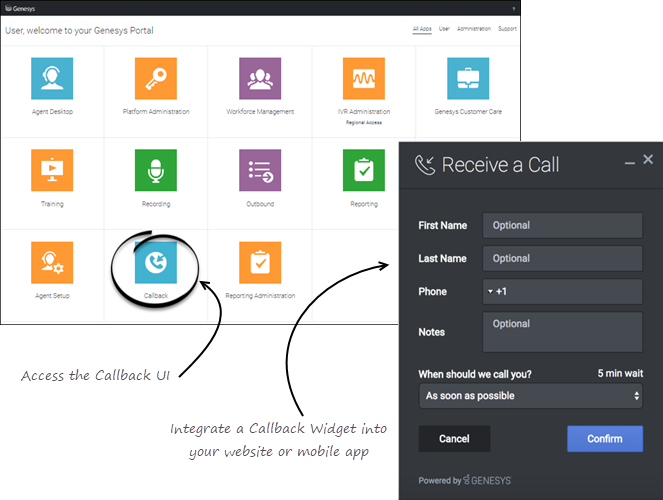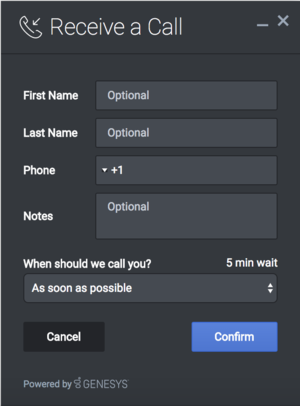How callback works
Find information about Genesys' callback offerings, which include classic callback services as well as more robust offerings that include Click-To-Call features and CAPTCHA integration.
Contents
What Callback does[edit source]
When calling a contact center, very few of us like to wait on hold. When wait times are long, many consumers would rather have someone call them back instead of waiting on the phone for an agent to answer.
Genesys offers classic callback services, allowing consumers to request a callback as soon as an agent with the correct skills is available or to schedule the callback for a specific day and time that is convenient. In addition, Genesys offers robust and feature-rich callback services so you can use Push Notifications and CAPTCHA widgets with your callback offering. You can monitor and manage your callback services in a UI, which includes a view of your callback queues. Key components of the consumer's app or web journey can be preserved for agent or reporting use.
On top of the traditional callback services and scenarios, Genesys also offers the Click-To-Call feature, which lets consumers call your contact center by simply tapping a button in your mobile app.
How Callback works[edit source]
Genesys offers callback services through a Callback Widget and through Genesys Callback. Genesys Callback and the Callback Widget are two separate offerings that work independently of one another.
Callback includes a UI with which you can provision callback features and manage your callback services. It uses Designer applications to provide callback services. The Callback UI is available on the Genesys portal.
The Callback Widget comprises a service and a customizable UI plugin that you integrate into your website. It provides basic callback service, either immediate or scheduled, based on agent availability. The service allows you to use the widget in order to schedule a callback, or to customize your own callback widget.
Providing callback services with Callback
Players: Administrators, Developers, Managers, Supervisors, Agents
Actions: Administrators use Agent Setup and Platform Administration to:
- Create and manage contact center resources such as virtual queues and agents. You require at least one queue and one agent to handle callbacks.
- Configure and manage permissions that govern user access to information and features in the Callback UI.
- Create the virtual queues that will be used for callbacks.
Administrators use Designer to provision callback-related applications. Callback works with Designer to do such things as:
- Connect consumers to agents who have the correct skills.
- Time out and purge expired or abandoned callbacks.
- Terminate callbacks when appropriate.
Callback Administrators, Developers, Supervisors, and Managers use the Callback UI to view and – if permissions allow it – manage callbacks and supported scenarios, including the ability to configure rules to manage the number of callbacks allowed in a given time frame or to limit the countries and numbers to which callbacks are allowed.
In addition to callback management, Callback Administrators and Developers use the Callback UI to incorporate Push Notification and CAPTCHA features into the user experience. The UI also provides information about errors, cross-origin resource sharing (CORS) domains, and queue configuration, all of which can be helpful when troubleshooting.
Managers and supervisors use the Pulse dashboard for real-time reporting about callbacks. Callback activity is tracked as part of the Queue reports. You can add a report widget based on the Callback Activity template to your dashboard.
For historical reporting about callbacks, managers and supervisors use Genesys Customer Experience Insights (GCXI) to generate reports.
Providing callback services with a widget
Players: Administrators, Developers, Managers, Supervisors, Agents
Actions:
CallbackService exposes high-level API access to Genesys callback services, allowing users to use the Callback Widget to schedule a callback with customer service. CallbackService and the matching Callback Widget work together right out of the box, and they share the same configuration object. Once the plugin is registered on the bus, you can call commands on other registered plugins and subscribe to and listen for published events.
The Callback Widget form fetches user details, such as name, phone number, and email—and whether the customer would like an immediate callback or at a specified time. Callback then submits this information to Customer Service. The widget is OS independent and can run on desktop and mobile devices.
Every Callback interaction has a sequence of events we describe as the 'Interaction Lifecycle'. This is a sequence of events that tracks progress and choices from the beginning of an interaction (opening Callback), to the end (closing Callback), and every step in between.
Each event in the Interaction Lifecycle includes a block of metadata, which contains Boolean state flags, counters, timestamps, and elapsed times. These values can be used to track and identify trends or issues with callback interactions.
Callback even allows you to customize the registration form shown to users prior to starting a session. Customization is done through an object definition that defines the layout, input type, label, and attributes for each input.









